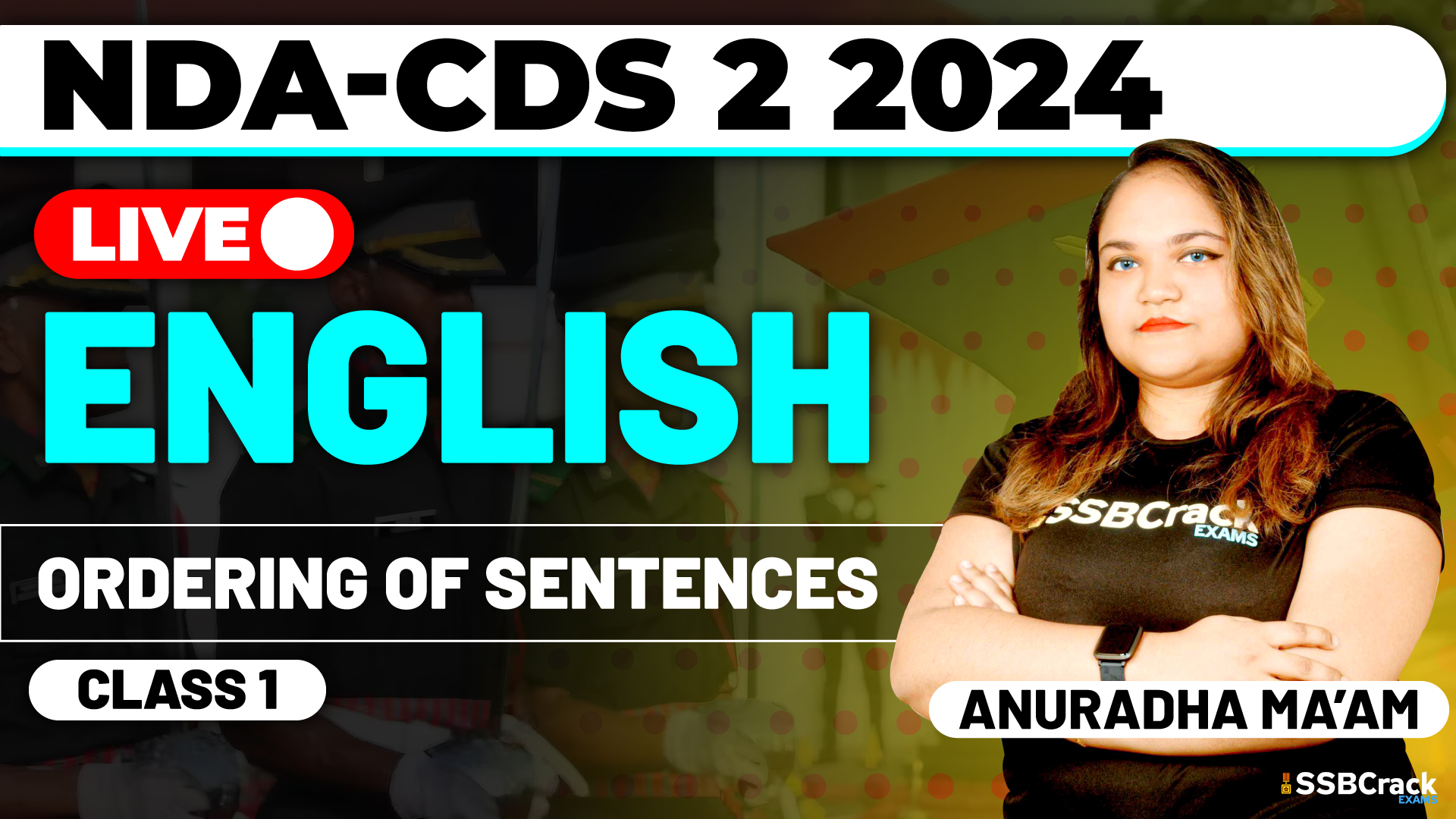The National Defence Academy (NDA) and Combined Defence Services (CDS) exams are prestigious gateways for aspirants aiming to join the Indian Armed Forces. Among the various sections tested, the English section holds significant importance in assessing a candidate’s language proficiency. One crucial component of this section is the topic of Ordering of Sentences, which evaluates a candidate’s ability to logically arrange sentences to form a coherent paragraph. This article delves into the importance of the Ordering of Sentences topic in the NDA and CDS 2 2024 exams and emphasizes the necessity of medium to advanced levels of reading skills and a solid understanding of sentence structure and formation to excel in this area. Additionally, it highlights some effective tricks and strategies that candidates can use to solve these questions efficiently.
Understanding the Exam Context
In both the NDA and CDS exams, the English section is designed to test candidates’ language skills, including vocabulary, grammar, comprehension, and logical structuring. The Ordering of Sentences topic specifically assesses a candidate’s ability to logically sequence sentences to form a meaningful paragraph. This skill is crucial for clear and effective communication, an essential attribute for future officers in the armed forces.
Directions: In questions below, each passage consist of six sentences. The first and sixth sentence are given in the beginning. The middle four sentences in each have been removed and jumbled up. These are labelled as P, Q, R and S. Find out the proper order for the four sentences.
Q) S1 : Bill Clinton is the President.
S6 : Looking at him, a lot of people feel surprise.
P : But that is not true of Mr. Clinton.
Q : This had led him to be a vegetarian.
R : His philosophy is ‘be simple’.
S : Men as powerful as him usually have lavish tastes.
The proper sequence should be
(a) S P Q R (b) S P R Q (c) R Q P S (d) P Q S R
Ans. (b)
Q) S1 : Man cannot survive except through his mind. He comes on Earth unarmed.
S6 : To plant he needs a process of thoughts, to hunt he needs weapons and to make weapons the process of thoughts.
P : Man has no claws, no fangs, no horns and no great strength of muscle.
Q : He can obtain food by force.
R : He must plant his food or hunt it.
S : His brain is his only weapon.
The proper sequence should be
(a) R S Q P (b) P Q S R (c) Q P R S (d) P S Q R
Ans. (d)
Q) S1 : For the average Indian tourist, the mention of Indonesia conjures visions of Bali and little else.
S6 : It is a pity since otherwise this largest archipelago in the world has much to offer to the international visitor.
P : With cash flow problems, the airline has had to cut down its overseas operations.
Q : Tourism has not been much of a priority in this predominately Muslim country of 210 million people.
R : The air connectivity through the national airline is also minimum.
S : This aspect is evident in the low budget allocated each year to this sector.
The proper sequence should be
(a) Q S R P (b) R P S Q (c) Q R S P (d) S Q P R
Ans. (a)
Q) S1 : I got on a colourful bus filled with all kinds of strange people.
S6 : It was a gate that neither separated nor connected anything from or to anything.
P : We arrived at a gate like the one in Salvador Dali’s paintings.
Q : The bus rode across the dirty expanses without roads.
R : At first, I wasn’t aware that the bus roof was loaded with drugs.
S : Everyone was filled with dust and often the wheels would sink into the soft soil.
The proper sequence should be
(a) S P Q R (b) Q R S P (c) R Q S P (d) R S P Q
Ans. (c)
Q) S1. The bureaucrat and the social worker are men of totally different orientations and styles of functioning.
S6. The world will be a better place to live in if they learn a little from each other.
P. The other is considered to be a man ever on the move.
Q. He is portrayed as a man fond of rules above all other things.
R. The one is regarded as given to sedentary habits, doing a lot of paper work.
S. Driven by an urge to help others he is impatient with red tape and unnecessary delays.
The proper sequence should be
(a) P Q R S (b) R Q P S (c) S R Q P (d) Q P S R
Ans. (b)
For more questioons, check out NDA-CDS 2 2024 Exam English Live – Ordering of Sentences – Class 1
Importance of the Ordering of Sentences Topic
1. Assessment of Logical Sequencing
Ordering of Sentences questions test a candidate’s ability to understand and apply logical sequencing. This involves recognizing the flow of ideas, understanding transitional phrases, and ensuring that the paragraph makes sense both grammatically and contextually.
2. Evaluation of Reading Skills
Engaging with this topic enhances overall reading skills. Candidates need to understand the context and flow of information quickly, making them better readers who can grasp complex ideas and narratives efficiently.
3. Improvement of Analytical Thinking
These questions require analytical thinking to identify the correct order of sentences. Understanding the relationships between sentences and their roles in a paragraph is crucial for solving these questions accurately.
4. High Scoring Potential
Ordering of Sentences questions can be a high-scoring area within the English section, provided candidates are well-prepared. These questions typically have definitive answers, allowing candidates to secure these marks with confidence and accuracy.
5. Application Across Exams
The inclusion of Ordering of Sentences in the English sections of various competitive exams, including NDA and CDS, highlights its universal importance. Mastering this topic benefits candidates across multiple exams, making it a valuable study focus for those appearing for more than one competitive test.
Key Strategies for Mastering Ordering of Sentences
- Understanding Paragraph Structure:
- Study the basic rules of paragraph structure, including the role of introductory sentences, supporting sentences, and concluding sentences. Familiarize yourself with common patterns of paragraph development.
- Regular Practice:
- Regularly practice arranging jumbled sentences to form coherent paragraphs. Use previous years’ question papers, mock tests, and online exercises to hone this skill.
- Reading Diverse Materials:
- Engage in reading a variety of materials, such as books, newspapers, and magazines. Exposure to different writing styles and structures helps in understanding how paragraphs are formed and the flow of ideas.
- Identifying Key Sentences:
- Learn to identify key sentences in a paragraph, such as topic sentences and concluding sentences. This helps in quickly determining the logical order of sentences.
- Use of Transitional Words:
- Pay attention to transitional words and phrases that indicate the flow of ideas, such as “however,” “therefore,” “moreover,” and “consequently.” These words provide clues about the relationships between sentences.
Tricks to Solve Ordering of Sentences Questions
- Identify the Topic Sentence:
- The topic sentence usually introduces the main idea of the paragraph. It is often the first sentence but can sometimes be placed later. Identifying this sentence helps in setting the context for the rest of the paragraph.
- Look for Supporting Details:
- Supporting sentences provide details, examples, or explanations related to the topic sentence. These sentences should logically follow the topic sentence.
- Detect Concluding Sentences:
- Concluding sentences typically summarize the main idea or provide a final thought. These sentences often come at the end of the paragraph.
- Use Logical Connectors:
- Look for logical connectors and transitional phrases that indicate the relationship between sentences. These connectors help in arranging sentences in a coherent order.
- Practice with Timed Exercises:
- Practice solving Ordering of Sentences questions within a set time limit. This helps in improving speed and accuracy, which are crucial during the exam.
Conclusion
The Ordering of Sentences topic is a crucial element of the English section in the NDA and CDS 2 2024 exams. Mastery of this topic requires medium to advanced levels of reading skills and a solid understanding of sentence structure. By studying paragraph formation rules, practicing regularly, reading diverse materials, and developing analytical thinking, candidates can significantly enhance their proficiency in this area. A strong command of sentence structure not only helps in scoring well in the exams but also equips future officers with the language skills necessary for effective communication in their professional roles. Utilizing the strategies and tricks mentioned above can help candidates approach these questions with confidence and accuracy, thereby maximizing their performance in the exams.



















